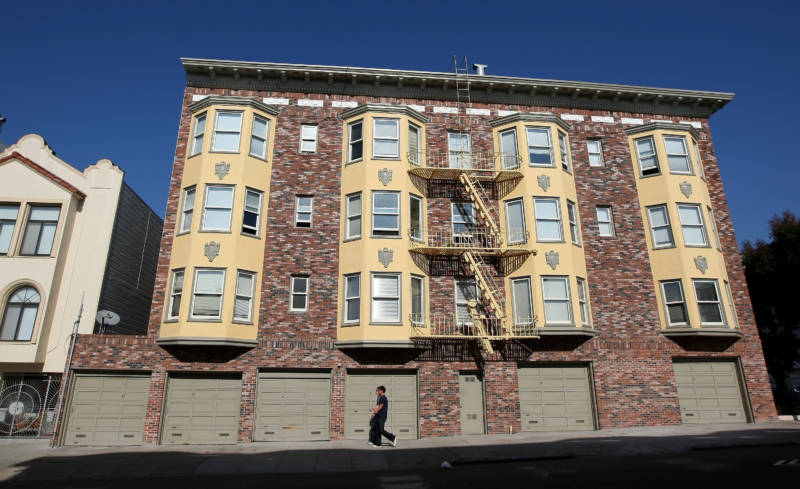Beyond the collapse of the Bay Bridge, some of the most enduring images of the 1989 Loma Prieta earthquake came out of San Francisco’s Marina and Mission districts, where buildings were destroyed, fires erupted and rescue dogs were brought in to sniff the rubble for the missing.
Thousands of This Type of Building Still at Risk of Collapse in Bay Area Earthquake

During the quake, the first stories of wood-framed residential buildings buckled, and some structures collapsed like Jenga towers with the bottom block removed.
Many of these buildings ascended from a first story with large windows, garages, or big doors, a design that compromised their structural framing.
In the last 30 years, and in the last decade in particular, urban planners across the region have pushed to reinforce these so-called soft-story structures, in recognition of their extreme vulnerability during a violent earthquake.
Since Loma Prieta, building owners and cities across the Bay Area have spent $1.2 billion on retrofits, according to a 2018 estimate by the U.S. Geological Survey.
Despite all this work, thousands of buildings across the region remain unremediated and at risk of collapse or severe damage.
“We are very fortunate in California that we have very good building codes now,” said Richard Allen, a Berkeley seismologist. “The challenge is that the older buildings are not up to those codes. When it comes to building safety, it comes down to when it was built.”
A huge amount of investment has gone into retrofitting these buildings, says Roland Burgmann, a geologist who teaches at UC Berkeley. “But there are still many structures that will not perform very well during an earthquake,” he said. “We are in much better shape than we used to be. But, if a really big one hits right in the Bay Area, it’s not going to be pretty.”
One problem is that the region’s building codes are governed by a patchwork of mandates and rules, says Douglas Given, an earthquake early-warning coordinator for USGS.
Even when cities have identified problematic buildings, they still struggle to get the work done, with funding as the biggest impediment, he says. “Either tax breaks or grants to get it done is what is needed.”
The problem has been complicated by the state’s housing crunch.
![Absence of adequate shear walls on the garage level exacerbated damage to this structure at the corner of Beach and Divisadero Streets, Marina District. [J.K. Nakata, U.S. Geological Survey]](https://ww2.kqed.org/science/wp-content/uploads/sites/35/2014/10/soft-story.jpeg)
“The work could take stock off the market, in some cases, or it would price people out of the building once the expense of the retrofit is built into the rent,” said Given.
In October 2013, San Francisco became the first major city in California to require property owners to retrofit their wood-frame apartments with an open-ground first floor.
San Francisco’s Department of Building Inspection has identified 4,921 total soft-story buildings that currently need to be fixed. Since the mandate, the city has received permit applications to make the upgrades on 98% of these structures, and 65% of them are now completed.
“Of course, hundred percent is our target,” said Tom Hui, director of the the building inspection department. “Right now, with 98% percent of owners applying for permits, that’s very encouraging. Of course, we need to finish all the seismic work.”
Hui said the issue is urgent and must be addressed soon.
“After the 1989 earthquake, we saw a lot of damage in the Marina District and the Mission District that affected thousands of people.”
Lagging Behind
Some cities, like Berkeley, Alameda and Fremont, have followed San Francisco in requiring retrofits for the 270, 100, and 22 soft-story buildings, respectively, within each city’s limits.
This year, Oakland adopted a similar ordinance for 1,500 buildings, and Palo Alto is considering one for its 300.
But other cities, like San Jose, haven’t even compiled a full list of vulnerable residents. James Son, deputy director of San Jose’s planning and building department, says the city estimates it has about 1,400 soft-story buildings
In the early 2000s, Son said, a city engineer worked with a research team from San Jose State University to identify these properties, but the information was destroyed. Son called the loss “unfortunate.”
The San Jose City Council has asked its staff to look into incentivizing earthquake retrofits for homeowners; it has yet to require the repairs.
“It comes down to cost,” Son said. “We are working on incentives that would be the most cost-effective and attractive to building owners to retrofit their soft-story. We know that seismic activity can be devastating.”
Mountain View has also yet to mandate retrofits for its 488 soft-story buildings divided into 5,100 residential units.
“We are aware of those seismic concerns and are working on it,” said Wayne Chen, assistant community development director for Mountain View. “At the city council’s direction, we’ve started on this as a priority work plan.”
Under the city’s rent-stabilization rules, landlords can petition to raise rents to cover the cost of city-mandated building improvements over time.
Chen says the city is exploring whether to mandate retrofits within this program.
To be sure, retrofitting is a major expense. Reinforcing a weak first floor in San Francisco can cost between $60,000 and $1 million, according to the USGS estimate.
But some critics say the Bay Area, which has led the state in soft-story mitigation, is falling behind and missing a chance to leverage a ballooning tax base amidst a red-hot tech economy to pay for necessary fixes.
Meanwhile, the earthquake hazard in the Bay Area remains high. A 2016 USGS earthquake forecast for the region found a 72% chance of at least a 6.7 magnitude earthquake sometime in the next 30 years.
